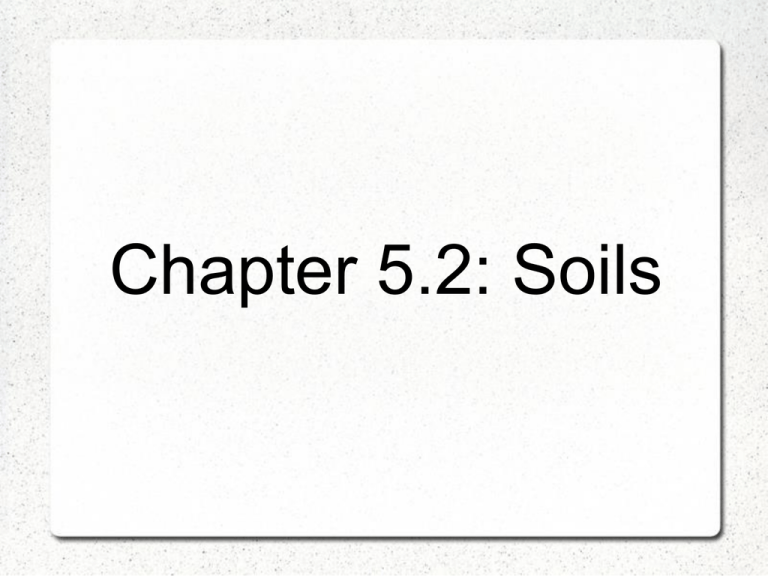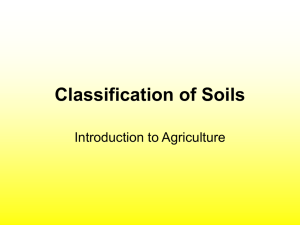Soil
advertisement

Chapter 5.2: Soils Soil: A Product of Weathering Weathering is normally thought of as destructive. However, if it were not for weathering, we would not have soils, which are an important natural byproduct of weathering. Imagine a world without soils. Without soils, there would be virtually no life on land. No terrestrial plants and animals. Soils Soil Composition Soil is made up of four parts. These four parts are mineral matter, organic matter, water, and air. The mineral matter of soil is the part that comes from broken rock. The organic matter of soil is composed of dead leaf litter, dead vegetation, dead animals etc. Another name for organic matter is humus. 4 Parts of Soil Soil Texture and Composition One way to determine a soil's composition and texture is to use a soil-texture diagram like the one shown here. Soil Formation The five most important factors that contribute to the way soils are formed are... Parent material – the source of the soil material. Where did the soil come from? Did it come from granite, sandstone, glacial till? Time – The longer a soil has been forming, the thicker it becomes; the more mechanical and chemical weathering it has been exposed to. Parent Material and Time Soil Formation Climate – The affect of climate on weathering is similar to the affect of climate on soils. Hot, humid climates have the most intense chemical weathering and as a result the soils are generally unproductive (poor in nutrients). Colder climates sometimes experience mechanical weathering (frost wedging, contraction/expansion etc.), but there is very little chemical weathering, so the soils are often more productive (nutrient rich). Climate and Soils Soil Formation Organisms – Living organisms also contribute to soil formation. Bacteria and fungi can help to break down the dead plants and animals and put nutrients into the soil. Earthworms and other burrowing animals help to aerate and hydrate the soil with air and water. Slope – The steepness of a slope can also play a factor in soil formation. Steeper slopes are affected more by erosion and have less soil than flat ground. Soil and Organisms Soil and Slope Soil Profiles Some soils change gradually from the top to the bottom. Others have distinct regions or layers that vary in texture and composition. One way to analyze soil layers is to look at a vertical section or column of soil called a soil profile. Most soils have a top layer of mineral matter mixed with organic matter. This top layer of soil is called the A horizon or the topsoil layer. Soil Profiles The next layer down, located below the A horizon is called the B horizon. The B horizon is often called the subsoil. The B horizon contains fine clay sediment that washed out of the A horizon. Sometimes the B horizon forms a hard impenetrable layer called hardpan. Soil Profiles The final layer is called the C horizon. The C horizon barely resembles what you would typically think a soil would look like. The C horizon is broken down solid bedrock. Soil Types Because there are so many different types of climates around the world, there are also many different types of soils. The three main types of soils are... Pedalfers – These soils form in temperate climates that receive moderate rainfall (63 cm). Generally nutrient-rich soils with lots of organic matter. This type of soil is most commonly found in the eastern half of the United States. Pedalfers Soil Types Pedocals – This soil type is found in the western United States that have grass and brush vegetation. Pedocals are typically found in dryer climates so chemical weathering is minimal. Because chemical weathering is small, Pedocal soils contain less clay and more calcite. Laterites – This soil type is found in hot, humid, tropical areas. Chemical weathering is severe. Very nutrient-poor soils. Pedocals Laterites







